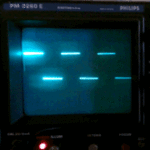ignas
Newbie level 4

I bough a used, nonworking oscilloscope Phillips PM3260e in attempt to fix it.
The symptom: there is no trace. Only when powering down it shows a disappearing beam on the CRT. (Maybe a leaky capacitor?)
First I checked the PSU, found few faulty capacitors with my ESR meter, replaced them. Now PSU seems fine, all voltages are correct.
But there's still no trace. After much trial and error, I narrowed it down to the DC restorer or the blanking circuit.

If I quickly short the cathode and the first grid of CRT (between GR522 and GR523 diodes) for an instant , I see a very bright trace and it looks OK.
I have no experience with CRT's, so how to isolate the problem even further?
Appreciate any help!
The symptom: there is no trace. Only when powering down it shows a disappearing beam on the CRT. (Maybe a leaky capacitor?)
First I checked the PSU, found few faulty capacitors with my ESR meter, replaced them. Now PSU seems fine, all voltages are correct.
But there's still no trace. After much trial and error, I narrowed it down to the DC restorer or the blanking circuit.

If I quickly short the cathode and the first grid of CRT (between GR522 and GR523 diodes) for an instant , I see a very bright trace and it looks OK.
I have no experience with CRT's, so how to isolate the problem even further?
Appreciate any help!
Last edited:


